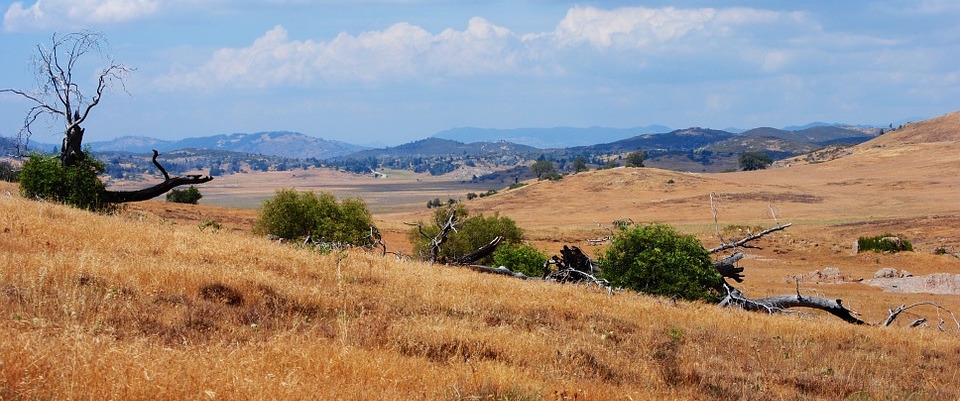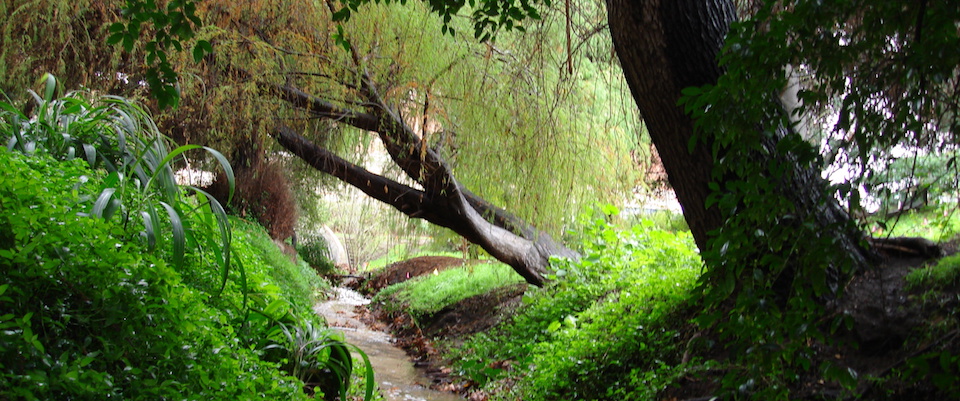Though Governor Brown has since lifted restrictions on water use, Californians still might want to think twice about a thirsty traditional lawn.
Gov. Jerry Brown’s recent drought response declaration confirmed what we all knew—there’s not enough water to go around—but it was as light as helium on the details. Oh, sure, it decreed a 25 percent cut-back for urban consumers, but it didn’t put any restrictions on agriculture, which uses 80 percent of the state’s developed water. And it didn’t specify on just how urbanites are supposed to achieve such reductions, beyond leaving it up to local water districts to enforce the necessary strictures.
Meanwhile, as everyone fumbles with drafting and implementing rationing policies, our reservoirs head for “dead pool” (that point at which water can no longer be drained through gravity) and our wells are sucking air. Someone has to do something.
Not to worry (or at least, not to panic): Someone—or rather, several folks at UC Berkeley’s College of Environmental Design—have done something. Specifically, a group of students under the direction of lecturer and horticulturalist Dawn Kooyumjian has published a 134-page booklet that includes four templates for drought-tolerant landscaping.
While all the designs use minimal water, they are hardly in the Astroturf-and-plastic-pink-flamingoes or four-cacti-a-and-a-bunch-of-rocks vein. Rather they are, well, quite lovely.
The first, the Herb Garden, is somewhat formal in design, employs useful, edible plants, and emphasizes rainwater capture. The second, the California Native Garden, incorporates year-round color, widely available plants, and easy installation and maintenance. The Lush and Dry Garden features desert plants that Kooyumjian characterizes as “easy to maintain, with interesting textures and colors,” while the Cottage Garden includes flowers and a small lawn.
Each template includes alternate designs for lots of varying dimensions and schema for both sunny and partially shaded conditions. Depending on the template, the average homeowner can expect to save 32,500 to 35,800 gallons of water compared to a traditional lawn. The pamphlet also contains general info on drought-related watering, pest controls, and plant options.
The booklet was created specifically for the San Lorenzo Village Homes Association. San Lorenzo Village, one of the nation’s first planned communities, was built shortly after World War II. The homeowners association incorporates 5,400 middle-class homes and serves 22,000 residents. Like all such developments, San Lorenzo Village has covenants: You can’t leave your trash can out on the curb all week long, you can’t keep your Christmas lights up until Easter—and lawns must be kept irrigated and green.
The association sends teams throughout town to ensure that the covenants are enforced. In January, shortly before the state declaration of a drought emergency, it was observed that quite a few lawns were browning off. Residents were notified of the covenant breach, and the homeowners association got some immediate push-back. The residents weren’t letting their lawns die out of sloth; they were trying to do something positive about the drought. They were deliberately using less water.
“People were very well aware of the drought, so some of them were cutting back on landscape irrigation,” says Kooyumjian. “Residents started coming into the homeowners association offices asking how they could both meet the covenants and respond to the drought.”
So homeowners association vice president Steve Kirk did the logical thing: He contacted professor Louise Mozingo at the College of Environmental Design and asked for help in developing plans that would allow residents to both meet the letter of the covenants and conserve water. Mozingo contacted Kooyumjian, and they agreed to approach the issue as a student project. StopWaste, an Alameda County agency tasked with reducing the county’s waste stream, signed on as a supporting partner, while the homeowner’s association underwrote the cost of the class.
The seven students (both graduate students and undergrads) handled every detail of the project, from calculating water usage for plant candidates to painting watercolors of the final designs, says Kooyumjian. “We had students with different skill sets and from different disciplines. We had students studying landscape architecture, one from urban studies, we had graphics designers and horticulturalists, but they all worked together seamlessly. It was really an impressive effort.”
The class circulated a survey to community residents, querying priorities and concerns. Then each student submitted a preliminary design to the homeowners for comment; these ultimately were refined to the four final plans. The four templates are now considered acceptable landscaping designs under San Lorenzo Village’s official CC&R (Covenants, Conditions and Restrictions).
“It turns out the association didn’t have to rewrite the CC&R to accommodate the new templates,” says Kooyumjian. “The codes require that half the landscaping must consist of ‘well-maintained’ vegetation, but they don’t specify lawns. So the association was able to avoid an expensive and time-consuming redrafting of the legal terms of the covenants.”
Mozingo says the project conforms to both the research and utility mandates of the College of Environmental Design.
“This is a perfect example of a small-scale project with very large implications. It points to the role of the larger urban landscape in building a more resource-efficient society,” says Mozingo, founding director of the Center for Resource Efficient Communities.
More, of course, must be done. Future initiatives could include graywater (used household water) and blackwater (sewage) treatment and recycling systems modularized for community or even neighborhood scales, ambitious stormwater harvesting systems, and the use of sophisticated fixtures, appliances and monitoring devices for both new and retrofitted buildings.
“And it’s not as though water stands separately when we consider efficiency,” says Mozingo. “It’s intertwined with energy. It takes a tremendous amount of energy to move water around, to convey it from source to consumer. So we have to consider that in both our water system and landscape design.”
For example, a healthy urban forest provides shade that can reduce energy use. The trees also sequester carbon and improve cityscape aesthetics. But trees require water, so that has to be figured in. What type of trees should you use for your specific urban forest? Which provide the most shade-producing canopy for the least amount of water and minimum maintenance? “We are responding to acute needs like San Lorenzo Village, but we’re also thinking long-term—50 to 100 years out.”



















